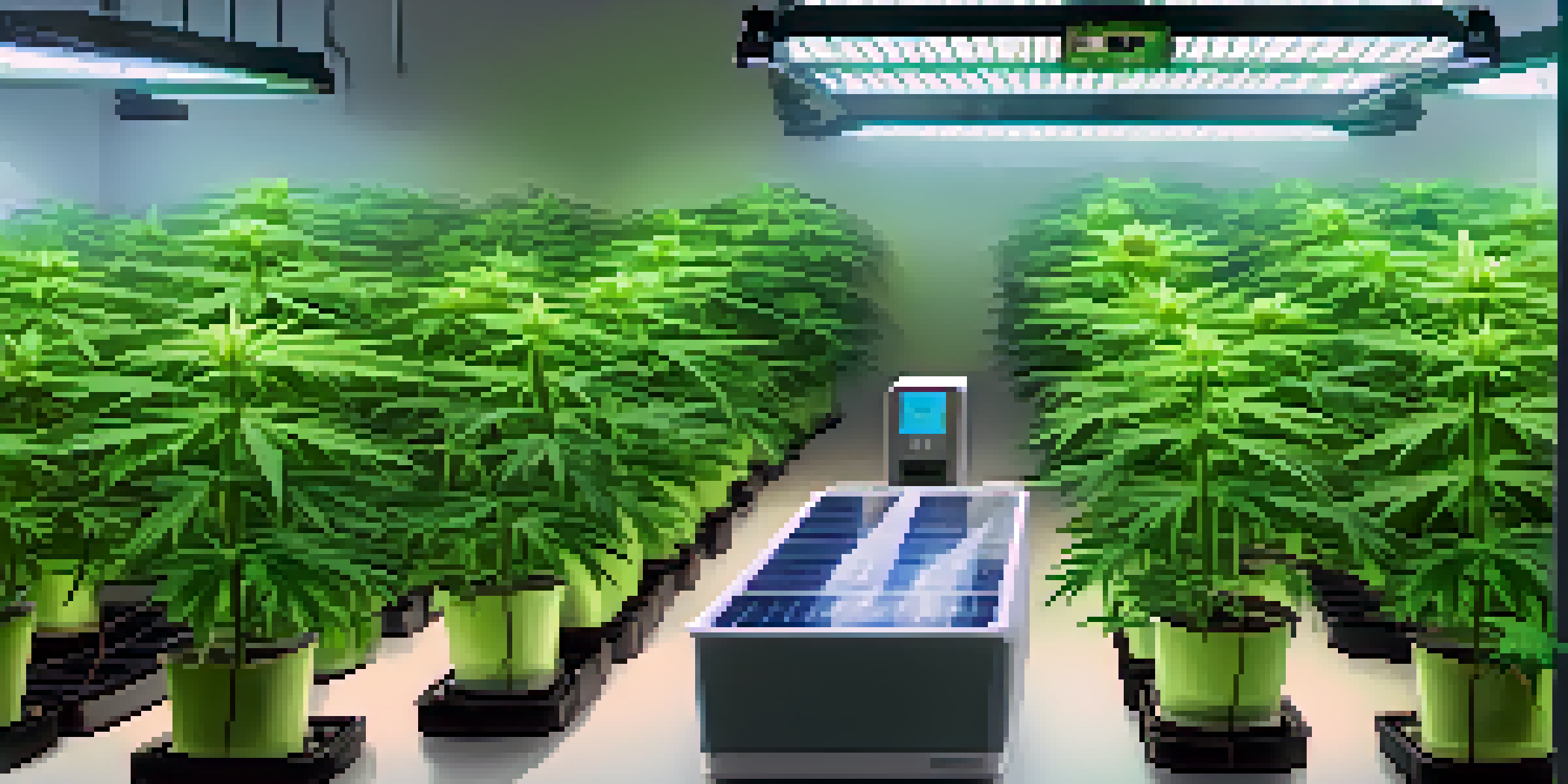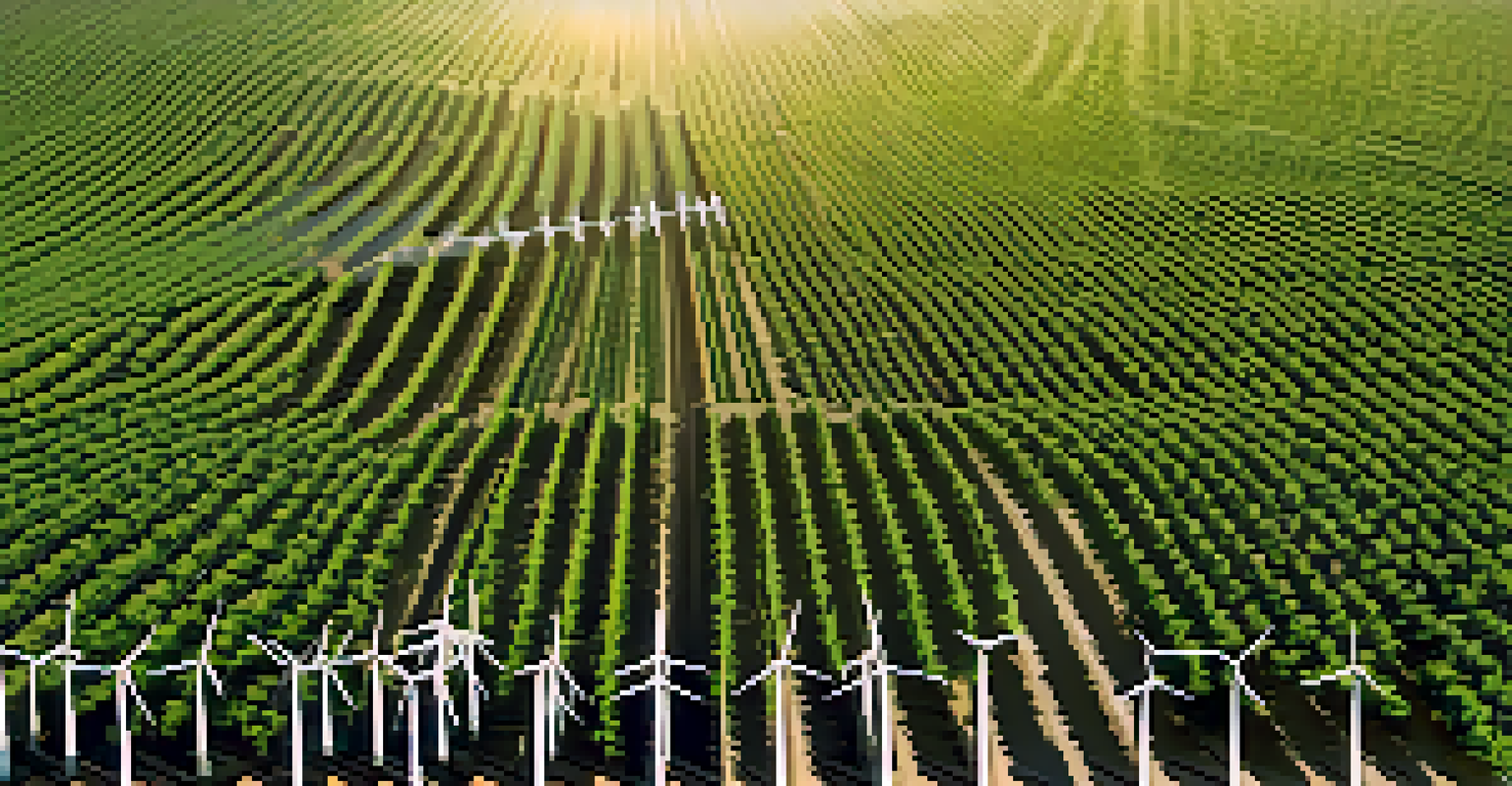Utilizing Renewable Energy Sources in Marijuana Grow Operations

Understanding Renewable Energy Sources for Cultivation
Renewable energy sources, such as solar, wind, and hydro, are becoming increasingly vital in various industries, including marijuana cultivation. These energy sources are not only sustainable but also help reduce the carbon footprint of grow operations. By harnessing renewable energy, cultivators can enjoy a more environmentally friendly approach while potentially lowering their energy costs.
The greatest threat to our planet is the belief that someone else will save it.
For instance, solar panels can be installed on the rooftops of greenhouses, converting sunlight into electricity. This energy can power grow lights, ventilation systems, and other essential equipment. Additionally, wind turbines can generate power for larger operations, particularly in areas with consistent wind patterns, further diversifying energy sources.
Understanding these energy options is the first step toward creating a more sustainable grow operation. As more cultivators recognize the benefits of renewable energy, the industry can make significant strides in reducing environmental impacts while maintaining productivity.
Benefits of Renewable Energy in Marijuana Operations
Utilizing renewable energy can significantly lower operational costs for marijuana grow operations. Traditional energy sources can be expensive, especially during peak usage times, but renewable options often provide a more stable and lower-cost alternative. This cost-saving can be reinvested into the business, whether for upgrading equipment or expanding the grow area.

Moreover, using renewable energy enhances a grower's reputation. As consumers become more environmentally conscious, they are likely to favor products from growers who prioritize sustainability. This can lead to increased sales and customer loyalty, as people feel good about supporting businesses that align with their values.
Renewable Energy Reduces Costs
Utilizing renewable energy sources can significantly lower operational costs for marijuana grow operations, allowing reinvestment into business growth.
In essence, the benefits of renewable energy extend beyond just savings; they also create a positive brand image and foster customer loyalty. By adopting these practices, marijuana growers position themselves as leaders in sustainability within the industry.
Solar Energy: Powering the Future of Cannabis Cultivation
Solar energy is one of the most accessible and widely adopted renewable energy sources for marijuana cultivation. By installing solar panels, growers can harness the sun's energy to power their operations, from lights to climate control systems. This not only reduces reliance on the grid but also promotes energy independence.
Renewable energy is not a choice anymore, it’s a necessity.
For example, many cultivators have reported significant savings on their electricity bills after transitioning to solar energy. These savings can be substantial, especially for large-scale operations that consume vast amounts of energy. Furthermore, government incentives and rebates can help offset the initial investment, making solar energy even more appealing.
Adopting solar energy not only supports cost savings but also aligns with eco-friendly practices. As the cannabis industry continues to grow, solar-powered operations stand out as a responsible choice, demonstrating a commitment to sustainability and environmental stewardship.
Wind Energy: An Efficient Option for Larger Grow Operations
Wind energy is another renewable option that can be particularly beneficial for larger marijuana grow operations. In areas with consistent wind patterns, wind turbines can generate substantial amounts of electricity, which can then be used to power various aspects of cultivation. This offers an alternative to solar energy, especially for growers who may not have sufficient sunlight year-round.
Investing in wind energy can also lead to long-term savings on energy costs. Once the initial setup is completed, the ongoing operational costs are generally lower compared to traditional energy sources. Additionally, wind energy systems can often be designed to integrate with existing infrastructure, making the transition smoother.
Solar Energy Enhances Sustainability
Adopting solar energy not only reduces reliance on traditional power sources but also aligns cannabis cultivation with eco-friendly practices.
Incorporating wind energy into a grow operation not only helps reduce costs but also showcases a commitment to innovation and sustainability. As the industry evolves, the use of wind energy can position growers as pioneers in adopting alternative energy solutions.
Hydroponics and Renewable Energy: A Perfect Match
Hydroponic systems, which grow plants without soil, are becoming increasingly popular among marijuana cultivators. When combined with renewable energy sources, these systems can thrive in a sustainable and efficient manner. The controlled environment of hydroponics allows for precise management of resources, making it a perfect fit for renewable energy integration.
For example, using solar energy to power hydroponic systems can enhance their efficiency. The energy generated can be used to regulate temperature, humidity, and nutrient delivery, optimizing conditions for plant growth. This not only improves yield but also minimizes waste, making the operation more sustainable.
By marrying hydroponics with renewable energy, cannabis growers can create a cutting-edge, eco-friendly cultivation method. This combination not only boosts productivity but also aligns with the growing demand for sustainable practices in the industry.
Regulatory Considerations for Renewable Energy Implementation
When considering renewable energy for marijuana grow operations, understanding the regulatory landscape is crucial. Different regions have varying laws and incentives regarding the use of renewable energy sources. Growers should familiarize themselves with local regulations to ensure compliance and take advantage of available programs that support renewable energy adoption.
For instance, some states offer tax credits or rebates for installing solar panels or wind turbines, making the investment more affordable. Additionally, growers should be aware of any zoning laws that might impact their ability to install renewable energy systems. Navigating these regulations can be complex, but it's essential for successful implementation.
Regulatory Knowledge is Key
Understanding local regulations and incentives is crucial for marijuana growers looking to implement renewable energy solutions effectively.
By staying informed about regulatory considerations, marijuana cultivators can effectively integrate renewable energy into their operations. This proactive approach can lead to better planning, increased savings, and a smoother transition to sustainable practices.
Future Trends: Renewable Energy in the Cannabis Industry
The future of the cannabis industry is likely to be significantly shaped by the adoption of renewable energy. As more growers recognize the benefits of sustainable practices, the trend toward renewable energy sources will continue to grow. This shift not only addresses environmental concerns but also meets the increasing consumer demand for eco-friendly products.
Emerging technologies, such as energy storage systems, will further enhance the feasibility of renewable energy in cannabis cultivation. These systems can store excess energy generated during peak production times, allowing growers to utilize that energy when demand is high. This innovation could lead to more efficient operations and greater energy independence.

In conclusion, the integration of renewable energy into marijuana grow operations is not just a trend but a necessary evolution for the industry. By embracing these sustainable practices, cultivators can ensure a brighter, more sustainable future for themselves and the planet.